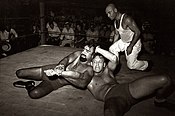This article has multiple issues. Please help improve it or discuss these issues on the talk page. (Learn how and when to remove these template messages)
|
| Part of a series on |
| Professional wrestling |
|---|
 |
The history of professional wrestling, as a performing art, started in the early 20th century, with predecessors in funfair and variety strongman and wrestling performances (which often involved match fixing) in 1830s. [1]
Professional wrestling is a popular form of entertainment in Australia, North America, Latin America, Europe, and Japan. Wrestling as a modern sport developed in the 19th century out of traditions of folk wrestling, emerging in the form of two styles of regulated competitive sport, "freestyle" and "Greco-Roman" wrestling (based on British and continental tradition, respectively), summarized under the term "amateur wrestling" by the beginning of the modern Olympics in 1896. The separation of "worked", i.e. purely performative, choreographed wrestling ("admitted fakery" or "kayfabe") from competitive sport began in the 1920s.
Its popularity declined during World War II, but was revived in the late 1940s to 1960s, the First Golden Age of professional wrestling in the United States, during which Gorgeous George gained mainstream popularity. In Mexico and Japan, the 1940s–1960s was also a Golden Age for professional wrestling, with El Santo becoming a Mexican folk hero, and Rikidōzan achieving similar fame in Japan.
There was a marked decline in public interest in the 1970s and early 1980s, but with the advent of cable television in the mid 1980s there followed a Second Golden Age as the United States experienced a professional-wrestling boom, with protagonists such as Hulk Hogan, André the Giant, "Macho Man" Randy Savage, Ric Flair and "Rowdy" Roddy Piper. The nature of professional wrestling was changed dramatically to better fit television, enhancing character traits and storylines. Television has also helped many wrestlers break into mainstream media, becoming influential celebrities and icons of popular culture. Wrestling's popularity boomed when independent enthusiasts unified and their media outlets grew in number, and became an international phenomenon in the 1980s with the expansion of the World Wrestling Federation (WWF, now known as World Wrestling Entertainment, shortened to simply WWE).
In the Third Golden Age, from the mid-1990s to early 2000s, during the Monday Night War, professional wrestling achieved highs in both viewership and financial success during a time of fierce competition among competing promotions, namely WWF (then in its "Attitude Era") versus World Championship Wrestling (WCW), with Extreme Championship Wrestling (ECW) also playing a major role.
Since the end of the Monday Night War, there has been another decline in popularity of professional wrestling; broadcasters have largely relegated Pro Wrestling Noah's Power Hour and New Japan Pro-Wrestling's World Pro Wrestling to the midnight hours, and WWE's television programs have seen relatively lower ratings, despite reporting record-high yearly earnings in 2018 and a modest spike in interest and viewership in 2019 and 2020.[2] This paralleled a renewed interest in competitive combat sports with the rise of mixed martial arts. Despite this, WWE has managed to establish itself as the leader of sports-oriented content on digital-viewership platforms, most notably on YouTube, where it commands the highest number of channel subscribers and video views for a sports channel.[3][4]
- ^ https://web.archive.org/web/20111011195312/http://fila-official.com/index.php?option=com_content&view=article&id=14&Itemid=100246&lang=en
- ^ "WWE® Reports Record Results For Fourth Quarter and Full Year 2018". corporate.wwe.com. Retrieved 2020-02-05.
- ^ "WWE Surpasses 60 Million YouTube Subscribers". WWE. Retrieved 2020-09-06.
- ^ "WWE's YouTube channel surpasses 40 billion views". FOX Sports. Retrieved 2020-09-06.
© MMXXIII Rich X Search. We shall prevail. All rights reserved. Rich X Search
